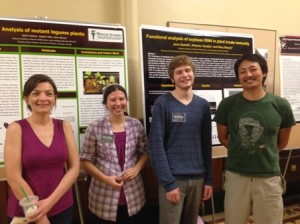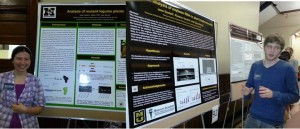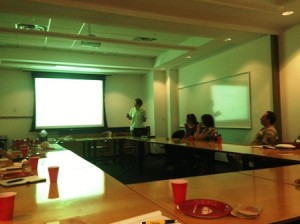This summer our lab welcomed Sarah and Jeno, two, very bright high school students from the Missouri Academy of Science, Mathematics and Computing for their internship. They spent two months in the lab to learn laboratory techniques and skills in plant molecular biology and genetics, the scientific discipline of their special interest.
Caption: Sarah and Jeno standing next to their mentors, Drs Katalin Toth and Kiwamu Tanaka during their poster presentation session at the Christopher Bond Life Sciences Center.
During the internship, Sara worked on phenotyping and genotyping of transposon insertion mutant lines of Lotus japonicus and Medicago truncatula. Meanwhile, Jeno conducted experiments to investigate the plant innate immunity response to bacterial pathogens.
Caption: Sarah and Jeno presenting their project to audience and visitors during the poster session at the Christopher Bond Life Sciences Center
In addition to learn techniques and skills, Sarah and Jeno have also learnt the processes of transforming laboratory experiment to the field experiment at the MU-Bradford farm. They are also engaged communication with senior researchers, post-doctoral fellows and graduate students in the lab through group and weekly lab meetings to advance their knowledge and experience in plant sciences.
Caption: Jeno presenting his project result, Sarah seating next to her parent and preparing for her turn at our regular lab meeting.
The following paragraphs are Sarah’ feelings and experiences during her 2-month internship in the Stacey Lab:
My name is Sarah Medina and I attend the Missouri Academy of Science, Mathematics, and Computing. I first heard about my internship opportunity from our school’s Dean, Dr. Samudzi Cleo. I emailed him to express my interest and he set up everything from there. My internship lasted roughly two months, starting on June 2nd and ending on July 26th. I would say on a typical day, I would be in the lab for four to six hours.
At the beginning of my internship, I worked with both Kiwamu and Katalin; as time went on, however, I worked exclusively with Katalin on my project. My main project involved genotyping two legume plants so they could be used further. From that, I learned how to extract DNA, how to run the Polymerase Chain Reaction (PCR) machine, and how to do gel electrophoresis. I did help out with the smaller lab tasks, like refilling pipette tip boxes and helping out in the field, but I didn’t mind. Going to the field was actually an interesting experience; I learned what a soybean mimic plant looked like, how a tractor helps with the planting, and I got to plant soybeans. It was hard work, but the kind that feels good to complete.
Aside from my project, I learned a lot of other useful laboratory skills. I learned how to use nanometer pipes and set up media for Petri dishes. I was also introduced to Soybase, a soybean database, and i learned how to do a BLAST search. I also had the opportunity to see how my mentor, Katalin, made the roots of her soybean plants transgenic.
Overall, I would say my internship was hard work, but worth it. The Stacey lab really made me feel at home. It was like we were all one big family. Sure, some things were intimidating (like the poster presentation we had to do on our major project), but I lived through them and am stronger for it. It was a great opportunity to explore life as a researcher, and I wouldn’t trade it for anything.




